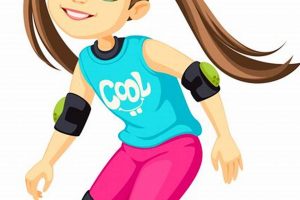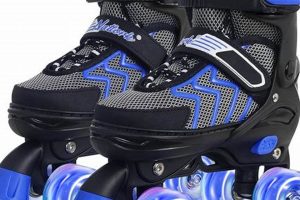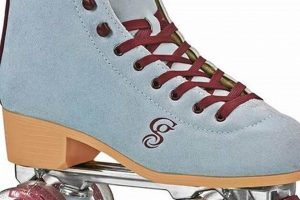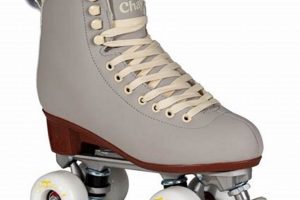These components are integral to the performance of roller skates, facilitating smooth and efficient wheel rotation. Situated within the hub of each wheel, these small, circular devices minimize friction between stationary and moving parts. Functionally, they allow the wheels to spin freely around the axle, directly influencing the skater’s speed and maneuverability. Consider, for instance, the difference between a skate with high-quality, well-lubricated units versus one with corroded or damaged parts; the former offers a noticeably superior skating experience.
The importance of these elements extends beyond mere convenience; it impacts skater safety and performance. Properly functioning parts contribute to consistent speed, making it easier to control movement and avoid unexpected stops or wobbles. Historically, advancements in material science and manufacturing techniques have led to more durable and precise devices, improving the overall quality and lifespan of roller skates. Furthermore, understanding the specifications and ratings of these components allows for informed selection based on individual skating styles and preferences.
This article will delve into the construction, types, maintenance, and selection criteria associated with these vital parts. Discussions will include ABEC ratings, material composition, lubrication techniques, and troubleshooting common issues, ultimately providing a thorough understanding of how to optimize roller skate performance and longevity.
Optimizing Roller Skate Performance
This section outlines essential considerations for maximizing the efficiency and lifespan of roller skates, directly related to the condition and maintenance of internal components.
Tip 1: Selecting Appropriate ABEC Ratings: Understand that the ABEC rating (Annular Bearing Engineering Committee) indicates manufacturing tolerances, not necessarily speed. Higher ABEC ratings (e.g., ABEC 7 or 9) denote tighter tolerances and smoother operation at high speeds, suitable for competitive skating. Lower ratings (e.g., ABEC 1 or 3) are often sufficient for recreational use.
Tip 2: Regular Cleaning and Lubrication: Contaminants such as dirt and debris impede the operation of these components. Regular cleaning, using appropriate solvents, followed by lubrication with a suitable lubricant (e.g., light machine oil or specialized bearing lubricant), is crucial for maintaining optimal performance and preventing premature wear.
Tip 3: Inspect for Damage: Periodically inspect each bearing for signs of damage, such as cracks, dents, or rust. Damaged units should be replaced immediately to prevent further damage to the wheel or axle and to ensure skater safety.
Tip 4: Consider Material Composition: These can be manufactured from various materials, including steel, ceramic, and hybrid combinations. Ceramic options offer superior corrosion resistance and reduced friction, particularly advantageous in wet or humid conditions. Steel options are generally more cost-effective but require more diligent maintenance.
Tip 5: Proper Installation: Ensure that these components are properly seated within the wheel hub. Incorrect installation can lead to misalignment, increased friction, and premature wear. Use a bearing press or appropriate tools to ensure proper seating.
Tip 6: Avoid Over-Tightening Axle Nuts: Over-tightening the axle nuts can compress components, restricting their ability to rotate freely. Tighten the nuts sufficiently to secure the wheels but avoid excessive force.
Tip 7: Replace Worn Components Promptly: Worn or damaged components should be replaced promptly. Continuing to use worn parts can lead to reduced performance, increased risk of failure, and potential damage to other components.
Consistent adherence to these guidelines will significantly contribute to enhanced roller skate performance, extended component lifespan, and improved skater safety.
The following sections will delve deeper into specific aspects of maintaining and optimizing roller skate equipment.
1. ABEC Rating
The Annular Bearing Engineering Committee (ABEC) rating is a system for classifying the manufacturing tolerances of bearings. While widely associated with roller skate wheel bearings, its relevance and implications require careful consideration to avoid misconceptions about its direct impact on skating performance.
- Manufacturing Tolerance
The ABEC scale (ranging from 1 to 9, with odd numbers only) indicates the precision with which a bearing is manufactured. Higher ratings signify tighter tolerances, meaning that the bearing’s components are more precisely shaped and assembled. A real-world example would be comparing a mass-produced bearing (e.g., ABEC 1) to one manufactured for high-speed machinery (e.g., ABEC 7). In the context of roller skate wheel bearings, tighter tolerances theoretically contribute to smoother, faster rotation, but this is only one factor influencing overall performance.
- Misconceptions About Speed
It is a common misconception that a higher ABEC rating directly translates to greater speed. While precision contributes to efficient rotation, other factors like lubrication, material quality, bearing design, and skater weight and technique play significant roles. A well-lubricated, properly maintained ABEC 3 bearing can often outperform a poorly maintained ABEC 7 bearing. Therefore, relying solely on the ABEC rating as an indicator of speed is an oversimplification.
- Practical Implications for Skaters
For recreational skaters, the practical difference between ABEC 3 and ABEC 7 bearings may be negligible. The increased cost associated with higher ABEC ratings may not justify the marginal performance gain. However, for competitive skaters or those engaging in high-speed disciplines, the tighter tolerances of higher-rated bearings could offer a competitive advantage. Skaters should consider their skating style, budget, and maintenance capabilities when selecting bearings.
- Beyond ABEC: Alternative Rating Systems and Features
It is important to recognize that the ABEC rating is not the only measure of bearing quality. Some manufacturers use proprietary rating systems or emphasize specific features such as material composition (e.g., ceramic bearings), seal design (e.g., rubber seals for dirt protection), or internal lubrication. These factors can significantly influence the performance and durability of roller skate wheel bearings, sometimes outweighing the importance of the ABEC rating itself.
In summary, the ABEC rating provides a useful indication of manufacturing precision, but it should not be the sole determinant when choosing roller skate wheel bearings. A holistic approach, considering factors beyond the ABEC rating, such as skating style, maintenance practices, and bearing features, will lead to more informed decisions and optimized skating performance.
2. Internal Lubrication
Internal lubrication is a critical determinant of roller skate wheel bearing performance and longevity. The lubricant minimizes friction between the bearing’s internal components the balls, races, and retainer enabling smoother and more efficient wheel rotation. Absence of adequate lubrication leads to increased friction, generating heat and accelerating wear. A practical example involves comparing two sets of identical bearings; one meticulously lubricated and the other neglected. The lubricated set will exhibit significantly reduced rolling resistance, translating to higher skating speeds and reduced effort from the skater. Conversely, the unlubricated set will degrade rapidly, potentially leading to bearing failure and posing safety risks.
Different types of lubricants cater to various skating styles and environmental conditions. Light oils are favored for speed skating due to their low viscosity, minimizing drag. Greases, with their higher viscosity, are suitable for aggressive skating or environments where bearings are exposed to contaminants, as they offer superior protection against dirt and moisture. The selection of an appropriate lubricant necessitates consideration of factors such as viscosity, operating temperature range, and compatibility with bearing materials. Applying an inappropriate lubricant can lead to issues such as increased friction, lubricant breakdown, or corrosion.
Effective internal lubrication is not a one-time application but requires regular maintenance. Over time, lubricants degrade due to oxidation, contamination, or shear forces. Periodic cleaning and re-lubrication are essential for maintaining optimal performance. Neglecting this maintenance can result in decreased skating efficiency, premature bearing failure, and increased replacement costs. Therefore, understanding the principles of internal lubrication and adhering to a consistent maintenance schedule are fundamental for maximizing the lifespan and performance of roller skate wheel bearings.
3. Material Composition
The material composition of roller skate wheel bearings significantly influences their performance, durability, and suitability for various skating applications. The choice of materials directly impacts the bearing’s ability to withstand load, resist corrosion, and maintain dimensional stability under varying temperatures. Steel, ceramic, and hybrid combinations are commonly employed. Steel bearings, typically made from high-carbon chromium steel, offer a balance of strength, hardness, and cost-effectiveness, making them suitable for general recreational use. However, steel is susceptible to corrosion in wet or humid environments, potentially leading to premature failure. Ceramic bearings, often utilizing silicon nitride (Si3N4), exhibit superior hardness, reduced friction, and excellent corrosion resistance. A practical example demonstrates this: a skater using steel bearings in coastal conditions may experience rust and degradation within a few months, while a skater using ceramic bearings in similar conditions may maintain optimal performance for a significantly longer period. The inherent properties of silicon nitride allow for smoother rolling and lower heat generation, advantageous for high-speed or competitive skating.
Hybrid bearings combine steel races with ceramic balls, seeking to leverage the benefits of both materials. The steel races provide structural integrity, while the ceramic balls reduce friction and weight. This combination enhances acceleration and reduces energy loss during skating. Furthermore, the retainer, a component that separates and positions the balls, is also subject to material variations. Retainers can be made from steel, nylon, or other polymers. Steel retainers offer durability, while nylon retainers are lighter and can reduce noise. The selection of retainer material depends on the intended application and performance requirements.
In conclusion, the material composition of roller skate wheel bearings is a critical design parameter that directly affects performance and lifespan. While steel bearings provide a cost-effective solution for general use, ceramic and hybrid bearings offer enhanced performance characteristics suitable for specialized applications. Understanding the properties and trade-offs associated with different materials enables informed selection, optimizing the skating experience and minimizing maintenance requirements. Challenges remain in balancing material costs with performance gains, as well as addressing the need for environmentally sustainable materials in bearing manufacturing. These factors collectively contribute to the ongoing evolution of roller skate wheel bearing technology.
4. Axle Compatibility
Axle compatibility is a fundamental consideration in the selection and installation of roller skate wheel bearings, directly impacting the functionality and safety of the skate. The inner diameter of the bearing must precisely match the axle diameter to ensure proper fit and secure wheel attachment. Incompatibility leads to several adverse effects: wheels may wobble, fail to rotate freely, or detach during use. A real-world instance involves using bearings with an incorrect inner diameter on standard 8mm axles; the wheels will exhibit excessive play, compromising stability and control. Conversely, attempting to force a bearing with an undersized inner diameter onto an axle can damage both components, rendering them unusable. The specification of “608” type bearings, with their standardized 8mm inner diameter, reflects an effort to promote compatibility across various skate models.
The relationship extends beyond simply matching diameters; axle length and threading also play a crucial role. If the axle is too short, it may not fully engage the bearing, resulting in insecure wheel mounting. Conversely, if the threading is damaged or incompatible with the axle nut, the wheel may loosen during skating, posing a significant safety hazard. Professional skate technicians emphasize the importance of verifying axle dimensions and thread integrity before installing new bearings. For example, some vintage skates utilize non-standard axle sizes, necessitating specialized bearings or axle conversions to ensure compatibility.
In summary, axle compatibility is a non-negotiable prerequisite for safe and effective roller skating. Mismatched components not only compromise performance but also introduce potentially dangerous instability. Careful attention to axle diameter, length, and threading, coupled with the selection of appropriately sized bearings, is essential. This understanding contributes directly to skater safety and optimizes the lifespan of both the bearings and the skates themselves.
5. Environmental Exposure
The operational environment significantly impacts the performance and lifespan of these mechanical components. Exposure to various elements necessitates careful consideration of materials, maintenance practices, and bearing design to mitigate potential degradation.
- Moisture and Humidity
High humidity and direct exposure to water promote corrosion in steel bearings. Rust formation increases friction, reduces rotational efficiency, and ultimately leads to bearing failure. Skaters in coastal regions or those frequently skating in wet conditions should consider bearings with corrosion-resistant materials or implement rigorous cleaning and lubrication protocols to mitigate these effects. For example, using a water-displacing lubricant after skating in wet conditions can extend bearing life.
- Particulate Matter
Dust, dirt, and debris act as abrasives, contaminating the internal lubricant and accelerating wear. Fine particles infiltrate the bearing, increasing friction and reducing rotational speed. Skating on rough surfaces or in industrial areas exacerbates this issue. Bearings with effective seals provide enhanced protection against particulate ingress. Regular cleaning and re-lubrication are essential to remove contaminants and maintain optimal performance. Bearings designed with labyrinth seals are less susceptible to contamination from the external environment.
- Temperature Fluctuations
Significant temperature variations affect lubricant viscosity and material properties. Extreme heat can cause lubricant breakdown, reducing its effectiveness and accelerating wear. Conversely, low temperatures can increase lubricant viscosity, resulting in increased rolling resistance. Bearings operating in environments with wide temperature swings require lubricants with stable viscosity across the operating range. Material expansion and contraction due to temperature changes can alter bearing clearances and affect performance.
- Chemical Exposure
Contact with chemicals, such as cleaning agents, road salts, or industrial pollutants, can degrade bearing materials and lubricants. Chemical exposure can lead to corrosion, embrittlement, and lubricant breakdown, compromising bearing integrity. Skaters operating in chemically contaminated environments should select bearings with chemically resistant materials and implement appropriate cleaning protocols to minimize exposure. Regular inspection for signs of chemical damage is essential.
In summary, environmental factors exert considerable influence on the functionality and durability of these parts. Proactive measures, including careful material selection, diligent maintenance practices, and the implementation of protective strategies, are essential for mitigating the adverse effects of environmental exposure and maximizing the lifespan and performance.
6. Rotational Friction
Rotational friction, a force resisting the turning motion of an object, is a key determinant of efficiency and performance in roller skate wheel bearings. Minimizing this friction is essential for achieving smooth, fast, and energy-efficient skating. The design, materials, and maintenance practices all influence the magnitude of rotational friction within the bearing system.
- Components of Friction
Rotational friction in a bearing arises from several sources, including rolling friction between the balls and races, sliding friction between the balls and the retainer, and viscous friction from the lubricant. Each component contributes to the overall resistance experienced by the rotating wheel. For example, a bearing with rough surface finishes will exhibit higher rolling friction compared to one with precision-ground surfaces. Similarly, a viscous lubricant will generate more drag than a low-viscosity lubricant.
- Material Selection and Surface Finish
The choice of materials and the quality of surface finish directly impact rotational friction. Harder materials with smoother surfaces exhibit lower friction coefficients. Ceramic balls, for instance, offer lower friction than steel balls due to their inherent properties. Polishing the races to reduce surface roughness also minimizes friction. Consider the contrast between a bearing with polished steel races and one with untreated races; the former allows for significantly smoother and faster wheel rotation.
- Lubrication Effects
Lubrication plays a crucial role in reducing rotational friction by separating the moving parts with a thin film of lubricant. The type and viscosity of the lubricant significantly influence friction. A properly selected lubricant minimizes direct contact between the balls and races, reducing both friction and wear. Conversely, an insufficient or contaminated lubricant increases friction and accelerates bearing degradation. A comparison between a well-lubricated bearing and a dry bearing highlights the dramatic difference in rotational resistance.
- Bearing Design and Preload
Bearing design parameters, such as ball size, race curvature, and preload, also affect rotational friction. Incorrect preload, either too high or too low, increases friction and reduces bearing life. Precision-engineered bearings with optimized designs minimize internal friction. For instance, bearings designed with optimized ball size and race curvature distribute the load more evenly, reducing stress and minimizing friction.
The interplay of these factors underscores the complexity of managing rotational friction in roller skate wheel bearings. Optimizing material selection, surface finish, lubrication, and bearing design are critical for achieving high performance and extended lifespan. Minimizing rotational friction translates directly into increased skating speed, reduced energy expenditure, and an enhanced overall skating experience.
7. Dimensional Precision
Dimensional precision is a critical attribute of these components, directly influencing their functionality and longevity. Minute deviations from specified measurements can compromise performance, leading to increased friction, premature wear, and potential failure. The inner diameter, outer diameter, and width of the bearing must adhere to strict tolerances to ensure proper fit within the wheel hub and on the axle. An example of dimensional imprecision would be a bearing with a slightly oversized outer diameter; attempting to press such a bearing into the wheel hub could result in damage to the hub or the bearing itself. Conversely, an undersized inner diameter would prevent proper seating on the axle, leading to instability and potential wheel detachment. The pursuit of precise dimensions during manufacturing is, therefore, not merely an exercise in quality control, but a fundamental requirement for safe and efficient roller skating.
The practical consequences of dimensional inaccuracies extend beyond immediate fitment issues. Over time, even minor deviations can compound due to the repetitive stress experienced during skating. A slightly out-of-round bearing, for example, will exhibit uneven load distribution, concentrating stress on specific areas. This concentrated stress accelerates wear and tear, reducing the bearing’s lifespan and potentially affecting the skater’s control. Furthermore, dimensional precision directly impacts the lubricant film thickness within the bearing. Inaccuracies can disrupt the formation of a consistent lubricant film, increasing friction and heat generation. The use of precision measuring instruments and stringent quality control procedures are essential for mitigating these risks.
In summation, dimensional precision is an indispensable characteristic of quality roller skate wheel bearings. It governs fitment, load distribution, lubricant film integrity, and overall performance. Deviations from specified dimensions, even seemingly minor ones, can have significant adverse consequences, affecting skater safety and bearing lifespan. The industry’s emphasis on precise manufacturing processes reflects a recognition of dimensional precision’s pivotal role in delivering reliable and high-performing roller skate equipment.
Frequently Asked Questions
This section addresses common inquiries regarding roller skate wheel bearings, providing concise and factual answers to enhance understanding and inform maintenance practices.
Question 1: What is the significance of the ABEC rating for roller skate wheel bearings?
The ABEC (Annular Bearing Engineering Committee) rating indicates the manufacturing tolerances of the bearing. Higher ABEC ratings signify tighter tolerances and increased precision, but do not directly correlate with speed or performance. Other factors such as lubrication, material quality, and skating style play significant roles.
Question 2: How often should roller skate wheel bearings be cleaned and lubricated?
Cleaning and lubrication frequency depend on usage and environmental conditions. Generally, bearings should be cleaned and lubricated after prolonged use, exposure to moisture or dirt, or when a noticeable decrease in performance is observed. A schedule of every 1-3 months for regular use is suggested.
Question 3: What type of lubricant is best suited for roller skate wheel bearings?
Light machine oil or specialized bearing lubricants are typically recommended. Heavier greases are suitable for wet or dirty conditions but can increase friction. The selected lubricant should be compatible with the bearing’s materials and operating temperature range.
Question 4: How does environmental exposure affect roller skate wheel bearings?
Exposure to moisture, dirt, and debris can accelerate wear and corrosion. Moisture promotes rust, while particulate matter contaminates the lubricant and increases friction. Protective measures, such as sealed bearings and regular cleaning, are essential.
Question 5: What are the symptoms of worn or damaged roller skate wheel bearings?
Symptoms include reduced speed, increased friction, unusual noises (e.g., grinding or squealing), wheel wobble, and difficulty turning. A thorough inspection of the bearing should be conducted to determine the extent of the damage.
Question 6: Can roller skate wheel bearings be upgraded for enhanced performance?
Upgrading is possible, but the benefits depend on the skater’s skill level and skating style. Ceramic bearings offer lower friction and increased durability, while higher ABEC-rated bearings provide tighter tolerances. However, proper maintenance remains crucial for realizing the full potential of any upgrade.
These questions and answers provide a foundational understanding of the maintenance and selection considerations for these components. Consistent upkeep and informed choices contribute significantly to skater safety and optimal performance.
The following section will present a maintenance schedule for roller skate wheel bearings.
Conclusion
The exploration herein has underscored the criticality of roller skate wheel bearings in achieving optimal skating performance and ensuring user safety. Detailed consideration of factors such as ABEC ratings, lubrication strategies, material composition, axle compatibility, environmental exposure mitigation, and the minimization of rotational friction has illuminated the multifaceted nature of bearing maintenance and selection. Further, an understanding of dimensional precision as a primary determinant of bearing longevity has been emphasized.
Given the significance of these components, proactive and informed maintenance practices are paramount. Continuing advancements in material science and bearing design promise further enhancements in performance and durability. It remains incumbent upon skaters to prioritize diligent upkeep and to make judicious choices, thereby maximizing the lifespan of their equipment and safeguarding against potential hazards.






![Boost Speed: Big Wheel Roller Skates - [Year] Guide Learn to Surf & Skate: A Beginner's Step-by-Step Guide Boost Speed: Big Wheel Roller Skates - [Year] Guide | Learn to Surf & Skate: A Beginner's Step-by-Step Guide](https://universitysurfandskate.com/wp-content/uploads/2025/12/th-719-300x200.jpg)
